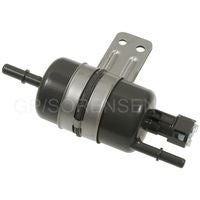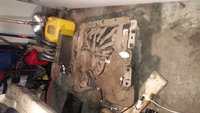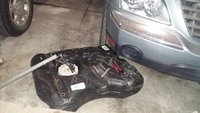Does the IAC valve affect acceleration at low speeds?
Asked by Majura Jan 20, 2017 at 04:35 PM about the 2002 Jeep Grand Cherokee Laredo
Question type: Maintenance & Repair
My 2002 Jeep Grand Cherokee V8 4..7 L has brand new components as follows:
(1) All 8 spark plugs
(2) All 8 injectors
(3) All 16 valve lifters
(4) MAPS
(5) Fuel Pressure Regulator
(6) All upstream Oxygen Sensors
(7) IAT
However, it has these three persistent and annoying problems:
(1) The engine starts and stops immediately unless the gas pedal is pressed on starting.
(2) Fast acceleration at low speeds does not work; after entering the highway, do not press the gas pedal hard because the engine does not provide enough torque for rapid acceleration at low speeds. In fact it, kind of, stalls.
(3) The CEL is on spitting many random and sometimes conflicting codes, most notably P0171, P0172, P0172, P0174, and P0175.
What the hell is going on in my engine? My head is thinking of IAC valve and the TPS; am I crazy?
23 Answers
Well I know the Throttle Position Sensor could account for some of this, along with the Mass Air Flow Sensor (MAF) and incorrect fuel pressure. On the TPS, what happens there is the wires brake under the insulation at the plugin. The only thing on that is I don't see a code there for that. Indications are from what I am reading from your codes that make sense would be MAF, Intake manifold leak and possible low fuel pressure. May want to check the fuel pressure. Your gonna have to start somewhere, and you want to eliminate one thing at a time to know when something changes. Some of these codes relating to the O2 sensors can be caused by what I suggested. You may want to clear the codes after fixing something to see what comes up next.
Thanks, It seems that the IAC and TPS have no effect, because I changed them a few minutes ago, and the engine behavior did not change. Reading online again, it seems that the problem could be the fuel pumb. I will change it tomorrow; however this experience is not very helpul since it is not clear if all compomemtys liested earlie were to be changed.
Diagnostics is about testing first, then replacing what is necessary. Just because a code comes up relating to something doesn't mean that item needs to be changed. It's all about testing. Yes I mentioned testing fuel pump pressure. The items above in your post I was under the understanding you had already put in. Did you check the wires at the plugin for the TPS by gently pulling on them, the wires should feel firm, if there is a broken wire it will stretch a bit, spongy. And at least clean the MAF sensor with electrical cleaner since that is not on your list.
The 2002 JEEP Grand Cherokee V8 has no MAF; it only has MAPS and IAT, both of which brand new, replaced just last week. Similarly, the fuel pressure regulator is also brand new, just replaced last week. At this time my only suspect remains the fuel pump, which seems to be a hell of work to DIY. Let me go to Autozone and check the fuel pressure first.
OK, I did the fuel pressure test and found it to be 55psi on idle condition, which agrees with the fuel pressure regulator setting. However, when the the gas pedal is pressed, the fuel pressure falls very fast to about 20psi depending on the engine RPM. Clearly this suggests that the one-way check valve in the fuel pump is leaking, which forces the whole fuel pump to be replaced. Am I correct?
Yes. The fuel injectors are designed to work under a certain amount of fuel pressure. On a Chevy for instance under 56 lbs to 52 lbs pressure you have a hard starting condition. under 50 lbs no fuel comes out of the injectors. I don't know what this fuel pressure is to be on yours, but in all the fuel pressure charts I have ever seen 20 lbs is way too low for fuel injection.
There may be a problem with the fuel regulator since you got 55psi testing at an idle.
You may be correct about the regulator. 2002 Jeep Grand Cherokee specifications require a fuel pressure of 50 psi plus or minus 5 psi, i.e., from 44.5psi to 54.2 psi. This one starts idle at the upper limit, which means it does not regulate, and possibly that is why the pressure falls down uncontrollably because the regulator does not work!. I will take it back to the store tomorrow, because they claimed it to have limited lifetime warranty; it is this one here
You seem to be a guy who is not afraid to get your hands dirty. Sometimes I am not good with words so I found this video on fuel pressure regulators that answer a lot of questions. It is 1/2 hr. long, you may want to subscribe to this guy or mark his page, he knows what he is talking about. So yes, I believe it is the fuel regulator. Keep me posted, I'm only trying to help. See next post...
For some reason, not posting, trying again.........https://youtu.be/zTK9-DoGIVY
Got a new fuel pump, which is the only major suspect at this time. Lowering the gas tank has not been fun; be prepared to spend two gallons of sweat and one gallon of beer. There is no clear information out there. (1) If you have a tow hitch, you have to remove the whole plastic rear bumper cover. Such information is not in any place I could reach. There are four hidden screws (two on each side) on the rear fender that must be unscrewed, and then several push pins to remove (most of them will break) and two torx screws below the rear lights (one on each side). After that, pull the plastic bumper cover from the sides first and then you can go ahead and remove the tow hitch assembly. -This step requires one gallon of sweat and three pints of beer (2) Disconnect the battery, then support the tank with a Jack under the tank skid shield, remove the remaining four chassis supporting bolts and the two heat shield nuts at the exhaust pipe passage. Lower the jack sightly for about two inches; this gives you access a whole lot of things on the tank. -This step also requires one gallon sweat and three pints of beer (3) Disconnect the power connection to the pump, disconnect the pressure and the return lines from the pressure regulator. Remove the filler hose and the vacuum vent hose. If your tank is full, then you can siphon drain it through the vacuum vent outlet. -This step does not need significant sweat, but will requires two pints of beer. At that time, I had finished by sweat supply so I abandoned the project until tomorrow when I get more sweat.
LOL...Wouldn't it just ben easier to try the fuel regulator? ROFLMAO!
The fuel pressure regulator is perfect. It is rated 55psi but operates at 50psi when the gas pedal is pressed if the fuel pump is is not leaking back. These regulators appear in two forms: the 35psi and the 55psi. Jeep Grange Cherokee V8 uses the 55psi.
Did you replace this? Did you get the fuel pump installed? Have you checked fuel pressure since?
My post disappeared; I will only show the pictures of what I did yesterday without narrating my experience, only that I was unable to drain the tank using that $3 Pennzoil Siphon Pump had bought from walmart. The Tank is very dirty, so today the first thing I will do is clean the dirt using compressed air before I drain the tank using its own pump. I will power it using 12V power supply unit. Aftar draining the tank I will disaable the pump and clean the tank with water. The whole system will be reassembled tomorrw, assuming everyting goes OK, Since I work on it only in the evenings, I should be able to drive it after tomorrow
Yea, your post did not show here, but it came in on my e-mail. It said Delta_2355 was the res-ponder. So not as much beer on that last one...
I had been away for some days but before going out of town, I was able to clean the tank and change the fuel pump. Removing the plastic tank from the shield was another mess because the two bolts that hold it in place had rusted to the extent no anti-rust fluid worked, so I had to grind them off. Removing the pump was another pain in the ass. Since I work on this beast at night only, I had to wait until next day to grab fuel pump repair tools from Autozone. I still suspect my old pump is good, but I have just replaced it. Now that I am back, I will rest for about three hours from now and then start working to reinstall the tank; it is damn heavy. I brought with me 2 gallons of beer and 5 gallons of sweat, so let us see how it ends.
I wish I was there to help...with the beer.
Thanks a lot for offering to help. I managed to reinstall the tank, with help of two 2.5 ton hydraulic jacks, and then reinstalled the tow hitch. reinstalling the tank was not taxing that much; just half a gallon of seat and one pint of beer. However, installing the tow hitch was a mess, since it cannot be supported by a jack, it need more than two hands, and that is where Rowefast's help was dearly needed. Eventually I used a rope to hang the tow hitch structure on the chassis close to the mounting place. At that point it was possible to jack it to the mounting place and insert the mounting bolts. In fact this task drained all my sweat and beer, therefore I added a dozen of curses. The good news is that in the end problem was been solved. Now the beast runs like it was manufactured yesterday! However, take this warning seriously: Never replace the fuel pump off the 2002 Jeep Grand Cherokee V8 in your home garage alone if it is equipped with a tow hitch unless you are crazy like me!
One thing I learned, the old fuel pump was running fine, however its filter was clearly very dirty; it is possible the filter was the problem, not the pump itself. However, I am no sure if it could have been wise to just change the filter and leave the pump in place knowing that it is OEM compared with the aftermarket pump I used as a replacement. The other observation is that it is possible that all sensors that I changed had nothing to do with the problem or their contribution was minor. At this time I think it was wise to change the oxygen sensors because probably they had been compromised by the unburned gases, soo on later they would have to be changed. The MAPS and IAT sensors cost less than 20 bucks both, so not reason to cry.
If I may add, and I'm going to anyway is that you need to start diagnosing any problems by scanning a vehicle for any trouble codes, to see if there related to the specific problem. Trouble codes need to be fixed anyway, but in this case if you read my first post, my thoughts were with a fuel pressure issue. There is no specific code that shows up for a bad fuel pump, plugged fuel pump screen, or even the fuel regulator. But low fuel pressure codes show up pertaining to like a miss in the engine for example. Then there are specific components to look at. Point being, doing the proper diagnostics will bring you to the problem.
This vehicle has some history. One of valve lifters went bad and engine had a very rough misfire, so I decided to change all valve lifters and spark plugs, which solved the problem. However after about a month, the CEL came on again. When I scanned, I had the P0172, P0175, P0133, and P0153. Thant sent me to change upstream oxygen sensors. This solved the problem for only two days, but then the car started loosing acceleration. At this time as it was loosing acceleration, it threw out multiple codes as I listed in my opening post. Definitely, my scanner is one of the cheap ones that cost less than a hundred bucks, so its codes are all generic. I wish I had paid $80 to get an auto shop scan for me using their sophisticated systems. However, despite complaining, I also feel good to have a strong justification for getting several pints of beer.




